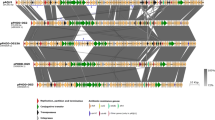Abstract
Pseudomonas sp isolated from the Bay of Bengal (Madras coast) contained a single large plasmid (pMR1) of 146 kb. Plasmid curing was not successful with mitomycin C, sodium dodecyl sulfate, acridine orange, nalidixic acid or heat. Transfer of mercury resistance from marinePseudomonas toEscherichia coli occurred during mixed culture incubation in liquid broth at 10−4 to 10−5 ml−1. However, transconjugants lacked the plasmid pMR1 and lost their ability to resist mercury. Transformation of pMR1 intoE. coli competent cells was successful; however, the efficiency of transformation (1.49×102 Hgr transformants μg−1 pMR1 DNA) was low.E. coli transformants containing the plasmid pMR1 conferred inducible resistance to mercury, arsenic and cadmium compounds similar to the parental strain, but with increased expression. The mercury resistant transformants exhibited mercury volatilization activity. A correlation existed between metal and antibiotic resistance in the plasmid pMR1.
Similar content being viewed by others
References
Aaronson S. 1970Experimental Microbial Ecology. London: Academic Press.
Allen DA, Austin B, Colwell RR. 1977 Antibiotic resistance patterns of metal tolerant bacteria isolated from an estuary.Animicrob Agents Chemother 12, 545–547.
Bale MJ, Fry JC, Day MJ. 1988 Transfer and occurrence of large mercury resistance plasmids in River Epilithon.Appl Environ Microbiol 54, 972–978.
Barkay T, Liebert C, Gillman M. 1989 Hybridization of DNA probes with whole community genome for detection of genes that encode microbial responses to pollutants:mer genes and Hg2+ resistance.Appl Environ Microbiol 55, 1574–1577.
Barkay T, Liebert C, Gillman M. 1970 Environmental significance of the potential former (Tn21)—mediated reduction of Hg2+ to Hg0 in natural waters.Appl Environ Microbiol 55, 1196–1202.
Bauer AW, Kirby WMM, Sherris JC, Twick M. 1966 Antibiotic susceptibility testing by a standardized single disk method.Am J Clin Pathol 45, 493–496.
Baya AM, Brayton PR, Brown NL, et al. Coincident plasmids and antimicrobial resistance in marine bacteria isolated from polluted and unpolluted Atlantic Ocean samples.Appl Environ Microbiol 51, 1285–1292.
Belliveau BH, Trevors JT. 1990 Mercury resistance determined by a self-transmissible plasmid inBacillus cereus 5.Biol Metals 3, 188–196.
Belliveau BH, Starodub ME, Cotter C, Trevors JT. 1987 Metal resistance and accumulation in bacteria.Biotechnol Adv 5, 101–127.
Birnboim HC, Doly J. 1979 A rapid alkaline extraction procedure for screening recombinant plasmid DNA.Nucleic Acids Res 7, 1513–1523.
Chakrabarty AM. 1976 Plasmids inPseudomonas.Annu Rev Genet 10, 7–30.
Curtiss R III. 1981 Gene transfer. In: Gerhardt P, et al. eds,Manual of Methods for General Bacteriology. Washington, DC: American Society for Microbiology; 243–265.
Dharmalingam K. 1985Gene Cloning and DNA Sequencing (Manual). National Biotechnological Board Workshop; V-26.
Don RH, Pemberton JM. 1981 Properties of six pesticide degradation plasmids isolated fromAlcaligenes paradoxus andAlcaligenes eutrophus.J Bacteriol 145, 681–686.
Foster TJ. 1983 Plasmid-determined resistance to antimicrobial drugs and toxic metal ions in bacteria.Microbiol Res 47, 361–409.
Gauthier MJ, Cauvin F, Breittmayer JP. 1985 Influence of salts and temperature on the transfer of mercury resistance from a marinePseudomonas toEscherichia coli.Appl Environ Microbiol 50, 38–40.
Jobling MG, Peters SE, Ritchie DA. 1988 Plasmid-borne mercury resistance in aquatic bacteria.FEMS Microbiol Lett 40, 31–37.
Kado CI, Liu ST. 1981 Rapid procedure for detection and isolation of large and small plasmids.J Bacteriol 145, 1365–1373.
Kondo I, Ishikawa T, Nakahara H. 1974 Mercury and cadmium resistances mediated by the penicillinase plasmidin Staphylococcus aureus.J Bacteriol 117, 1–7.
Laddaga RA, Bessen R, Silver S. 1988 Cadmium-resistant mutant ofBacillus subtilis 168 with reduced cadmium uptake.J Bacteriol 162, 1106–1110.
Mahler I, Levinson HI, Wang Y, Halvorson HO. 1986 Cadmium-resistant and mercury-resistantBacillus strains from a slat marsh and from Boston Harbour, USA.Appl Environ Microbiol 52, 1293–1298.
Maniatis T, Fritsch EF, Sambrook J. 1982Molecular Cloning: A Laboratory Manual. Cold Spring Harbour, NY: Cold Spring Harbour Laboratory Press.
Mobley HLT, Rosen BP. 1982 Energetics of plasmidmediated arsenate resistance inEscherichia coli.Proc Natl Acad Sci USA 79, 6119–6122.
Nakamura K, Nakahara H. 1988 Simplified X-ray film method for detection of bacterial volatilization of mercury chloride byEscherichia coli.Appl Environ Microbiol 54, 2871–2873.
Novick RP, Roth C. 1968 Plasmid-linked resistance to inorganic salts inStaphylococcus aureus.J Bacteriol 95, 1335–1342.
Pickup RW, Lewis RJ, Williams PJ. (1983)Pseudomonas sp. MT14, a soil isolate which contains two large catabolic plasmids, one a TOL plasmid and one coding for phenyl mercury acetate catabolism and mercury resistance.J Bacteriol 129, 153–158.
Rajini Rani DB, Mahadevan A (1989) Plasmid encoded metal resistance in bacteria.J Sci Ind Res 48, 338–345.
Rochelle PA, Fry JC, Day MJ. 1989 Factors affecting conjugal transfer of plasmids encoding mercury resistance from pure cultures and mixed natural suspension of Epilithic bacteria.J Gen Microbiol 135, 409–424.
Schottel L, Mandal A, Clark D, Silver S, Hedges RW. 1974 Volatilization of mercury and organomercurials determined by F-factor systems in enteric bacilli.Nature 251, 335–337.
Shiratori T, Inoue C, Sugawara K, Kusano T, Kitagawa Y. 1989 Cloning and expression ofThiobacillus ferrooxidans mercury ion resistance inEscherichia coli.J Bacteriol 171, 3458–3464.
Silver S, Keach D. 1982 Energy-dependent arsenate efflux: the mechanisms of plasmid-mediated resistance.Proc Natl Acad Sci USA 79, 6114–6118.
Silver S, Misra TK. 1988 Plasmid-mediated heavy metal resistances.Microbiol Rev 42, 717–743.
Silver S, Rosen BP, Misra TK. 1986 DNA sequencing analysis of mercuric and arsenic resistance operons of plasmids from Gram-negative and Gram-positive bacteria.GIM Proceedings. September.
Summers AO, Barkay T. 1989 Metal resistance genes in the environment In: Levy SB, Miller RV, eds.Gene Transfer in the Environment. 286–308.
Ulaganathan K, Mahadevan A. 1989 UMA-DNA: a computer programme in basic for DNA sequence analysis: In:The National Seminar on Molecular Plant Pathology. Madras: University of Madras; 25.
Wang Y, Mahler I, Levinson HS, Halvorson HO. 1987 Cloning and expression inEscherichia coli of chromosomal mercury resistance genes from aBacillus sp.J Bacteriol 169, 4848–4851.
Weiss AA, Murphy SD, Silver S. 1977 Mercury and organomercurial resistance determined by plasmids inS. aureus.J Bacteriol 132, 197–208.
Witte W, Green L, Misra TK, Silver S. 1986 Resistance to mercury and the cadmium in chromosomally resistantStaphylococcus aureus.Antimicrob Agents Chemother 29, 663–669.
Author information
Authors and Affiliations
Rights and permissions
About this article
Cite this article
Rani, D.B.R., Mahadevan, A. Plasmid mediated metal and antibiotic resistance in marinePseudomonas . Biometals 5, 73–80 (1992). https://doi.org/10.1007/BF01062217
Received:
Accepted:
Issue Date:
DOI: https://doi.org/10.1007/BF01062217




